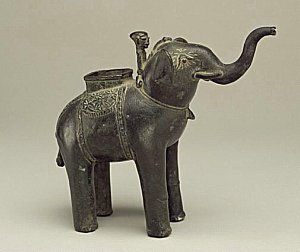Vietnamese Art in the Norton Simon Museum
Drum, 3rd century B.C.E. - 1st century C.E, Vietnam, -299-99. Bronze, 20 x 26 in. (50.8 x 66.0 cm). Jennifer Jones Simon Art Trust, N.1981.4.S © 2009 Jennifer Jones Simon Art Trust
Elephant with Driver, 14th-15th century, Vietnam, 1300-1499, Bronze. 6-3/4 x 7-1/4 x 3-1/2 in. (17.1 x 18.4 x 8.3 cm) Norton Simon Museum, Gift of Pratap and Chitra Pal. P.2003.01.01 © 2009 Norton Simon Museum
Celestial Female, c.1100, Vietnam: ancient Champa kingdom, 1075-1125, Sandstone, 28 x 13-1/4 x 9 in. (71.1 x 33.7 x 22.9 cm) Norton Simon Art Foundation. M.1977.20.2.S © 2009 Norton Simon Art Foundation
This "Celestial Female" may represent the river goddess Ganga, who is always personified as a beautiful woman.
Architectural Piece with Makara, c.1100, Vietnam: ancient Champa kingdom, 1075-1125, Sandstone, 35-1/2 x 41-3/8 in. (90.2 x 105.1 cm) Norton Simon Art Foundation. M.1977.20.1.S © 2009 Norton Simon Art Foundation
Shown in profile, a "Mythical Animal (Makara)" is about to swallow a male figure who holds a sword. In Indian mythology, heroes are said to extract pearls from the makara's mouth.
Shiva with Uma and Bull, 10th-11th century, Vietnam: ancient Champa kingdom, 900-1099. Sandstone, 24-1/4 x 18 x 7 in. (61.6 x 45.7 x 17.8 cm) The Norton Simon Foundation, F.1975.13.4.S © 2009 The Norton Simon Foundation
As in Cambodia, both Hinduism and Buddhism flourished in ancient Champa, in what is now Vietnam. Flanked by his mount, the bull, with his wife in a more casual attitude, Shiva is seated in a hieratic posture. Curiously, the Hindu god is portrayed in both an anthropomorphic, or human, form and a symbolic form, as the shape of the stele behind the group suggests a linga.

/https%3A%2F%2Fprofilepics.canalblog.com%2Fprofilepics%2F1%2F0%2F100183.jpg)






/http%3A%2F%2Fstorage.canalblog.com%2F57%2F13%2F119589%2F66288711_p.jpg)
/http%3A%2F%2Fstorage.canalblog.com%2F64%2F33%2F577050%2F65641082_o.jpg)
/http%3A%2F%2Fstorage.canalblog.com%2F57%2F80%2F577050%2F65456950_o.jpg)
/http%3A%2F%2Fstorage.canalblog.com%2F67%2F23%2F119589%2F65455871_p.jpg)